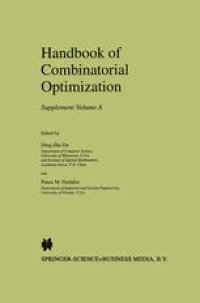
Ebook: Handbook of Combinatorial Optimization: Supplement Volume A
- Tags: Combinatorics, Discrete Mathematics in Computer Science, Theory of Computation, Information and Communication Circuits
- Year: 1999
- Publisher: Springer US
- Edition: 1
- Language: English
- pdf
Combinatorial (or discrete) optimization is one of the most active fields in the interface of operations research, computer science, and applied math ematics. Combinatorial optimization problems arise in various applications, including communications network design, VLSI design, machine vision, air line crew scheduling, corporate planning, computer-aided design and man ufacturing, database query design, cellular telephone frequency assignment, constraint directed reasoning, and computational biology. Furthermore, combinatorial optimization problems occur in many diverse areas such as linear and integer programming, graph theory, artificial intelligence, and number theory. All these problems, when formulated mathematically as the minimization or maximization of a certain function defined on some domain, have a commonality of discreteness. Historically, combinatorial optimization starts with linear programming. Linear programming has an entire range of important applications including production planning and distribution, personnel assignment, finance, alloca tion of economic resources, circuit simulation, and control systems. Leonid Kantorovich and Tjalling Koopmans received the Nobel Prize (1975) for their work on the optimal allocation of resources. Two important discover ies, the ellipsoid method (1979) and interior point approaches (1984) both provide polynomial time algorithms for linear programming. These algo rithms have had a profound effect in combinatorial optimization. Many polynomial-time solvable combinatorial optimization problems are special cases of linear programming (e.g. matching and maximum flow). In addi tion, linear programming relaxations are often the basis for many approxi mation algorithms for solving NP-hard problems (e.g. dual heuristics).
This volume can be considered as a supplementary volume to the major three-volume Handbook of Combinatorial Optimization published by Kluwer. It can also be regarded as a stand-alone volume which presents chapters dealing with various aspects of the subject including optimization problems and algorithmic approaches for discrete problems.
Audience: All those who use combinatorial optimization methods to model and solve problems.
This volume can be considered as a supplementary volume to the major three-volume Handbook of Combinatorial Optimization published by Kluwer. It can also be regarded as a stand-alone volume which presents chapters dealing with various aspects of the subject including optimization problems and algorithmic approaches for discrete problems.
Audience: All those who use combinatorial optimization methods to model and solve problems.
Content:
Front Matter....Pages i-viii
The Maximum Clique Problem....Pages 1-74
Linear Assignment Problems and Extensions....Pages 75-149
Bin Packing Approximation Algorithms: Combinatorial Analysis....Pages 151-207
Feedback Set Problems....Pages 209-258
Neural Networks Approaches for Combinatorial Optimization Problems....Pages 259-293
Frequency Assignment Problems....Pages 295-377
Algorithms for the Satisfiability (SAT) Problem....Pages 379-572
The Steiner Ratio of L p -planes....Pages 573-589
A Cogitative Algorithm for Solving the Equal Circles Packing Problem....Pages 591-605
Back Matter....Pages 607-648
This volume can be considered as a supplementary volume to the major three-volume Handbook of Combinatorial Optimization published by Kluwer. It can also be regarded as a stand-alone volume which presents chapters dealing with various aspects of the subject including optimization problems and algorithmic approaches for discrete problems.
Audience: All those who use combinatorial optimization methods to model and solve problems.
Content:
Front Matter....Pages i-viii
The Maximum Clique Problem....Pages 1-74
Linear Assignment Problems and Extensions....Pages 75-149
Bin Packing Approximation Algorithms: Combinatorial Analysis....Pages 151-207
Feedback Set Problems....Pages 209-258
Neural Networks Approaches for Combinatorial Optimization Problems....Pages 259-293
Frequency Assignment Problems....Pages 295-377
Algorithms for the Satisfiability (SAT) Problem....Pages 379-572
The Steiner Ratio of L p -planes....Pages 573-589
A Cogitative Algorithm for Solving the Equal Circles Packing Problem....Pages 591-605
Back Matter....Pages 607-648
....